Winter 2022
WhenWinterisMorethanaSeason
 byLydiaFairchok
byLydiaFairchok
www.riding-instructor.com
Official Publication of The American Riding Instructors Association





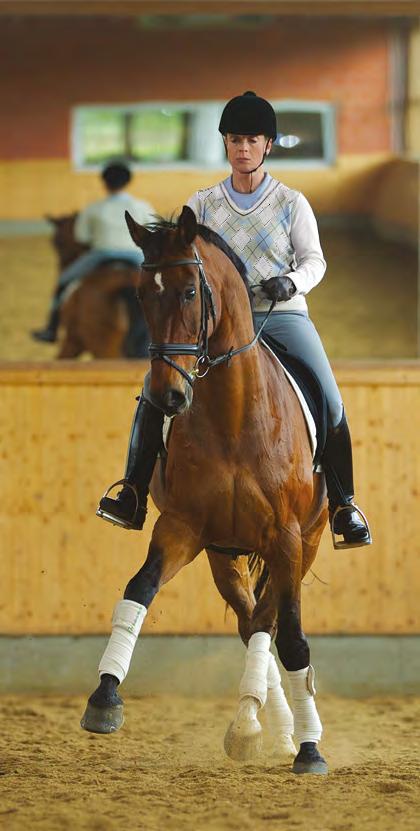
“Whatever level you ride, you can completely trust in a Wintec saddle. Throughout my dressage career most of my successes were achieved in a Wintec – even Olympic gold!” -Isabell Werth World Dressage Champion
She did it in a Wintec! WIN time to model shown Wintec Isabell @wintecsaddles Share your story Find your next Wintec saddle at wintec-saddles.com @wintec.saddles Official Saddle Supplier of the American Riding Instructors Association Official Saddle Sponsor of the United
Pony Club
World Dressage Champion Isabell Werth and Satchmo
States
Winter 2022
Published by: American Riding Instructors Association P.O. Box 366 Alton, NH 03809-0366 Tel: 603-605-5275
E-mail: aria@riding-instructor.com Website: www.riding-instructor.com
Director: William Watson aria@riding-instructor.com
Manager of Corporate Sponsorship and Advertising: Donna Hartshorn Tel 407-927-3578
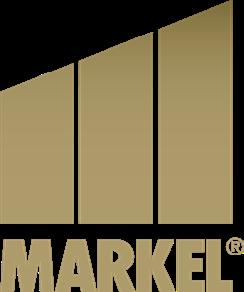
Art Director: Ferenc Rozumberski franzz@gmail.com
ARIA Official Suppliers and Sponsors
These companies, whose commitment to quality reflects our own, are official suppliers and sponsors of the American Riding Instructors Association. We thank them for their support, which helps us to continue our work.

www.stephens.edu/academics/ undergraduate-programs/equestrian-studies/ ARIA Official Sponsor


www.business.louisville.edu/ learnmore/uoflequine/ ARIA Official Sponsor

Member
ARIA recognizes that equestrian headgear that does not meet the current ASTM standard is not safe, although certain equestrian activities pictured in this magazine may not adhere to these requirements.
Riding Instructor is the Official Publication of the American Riding Instructors Association.
For Advertising Rates & Data, please contact the publisher.
The editor of Riding Instructor reserves the right to edit reasonably all copy submitted, and all contributions become the property of Riding Instructor. The Editor does not hold himself responsible for, nor does he necessarily agree with, the opinions expressed in Riding Instructor Riding Instructor assumes no responsibility for loss or damage to unsolicited photographs or manuscripts.
Reproductions without permission are strictly prohibited by copyright laws. While endeavoring to accept only reliable advertising, Riding Instructor will not be responsible to the public for advertisements, and the right to decline or discontinue any advertisement is reserved.
ARICP Advisory Board
Debi DeTurk Peloso
Denny Emerson
Julie I. Fershtman, Esq.
Charlotte Brailey Kneeland * Founder
Gayle Lampe
Sarah Sliva, MD
www.cazenovia.edu/caz-equine ARIA Official Sponsor

To
www.wellpride.com ARIA’s Official Fish Oil Supplier www.wintec-saddles.com ARIA’s Official Saddle Supplier
www.horseinsurance.com ARIA’s Official Insurance Supplier

learn
ARIA Official Sponsor
Winter 2022 | Riding Instructor 3
Linda Tellington-Jones the
benefits of becoming an ARIA Official Supplier or Sponsor, please contact ARIA at 603-605-5275 or
aria@riding-instructor.com
www.williamwoods.edu/eqs
Equine Industry Program
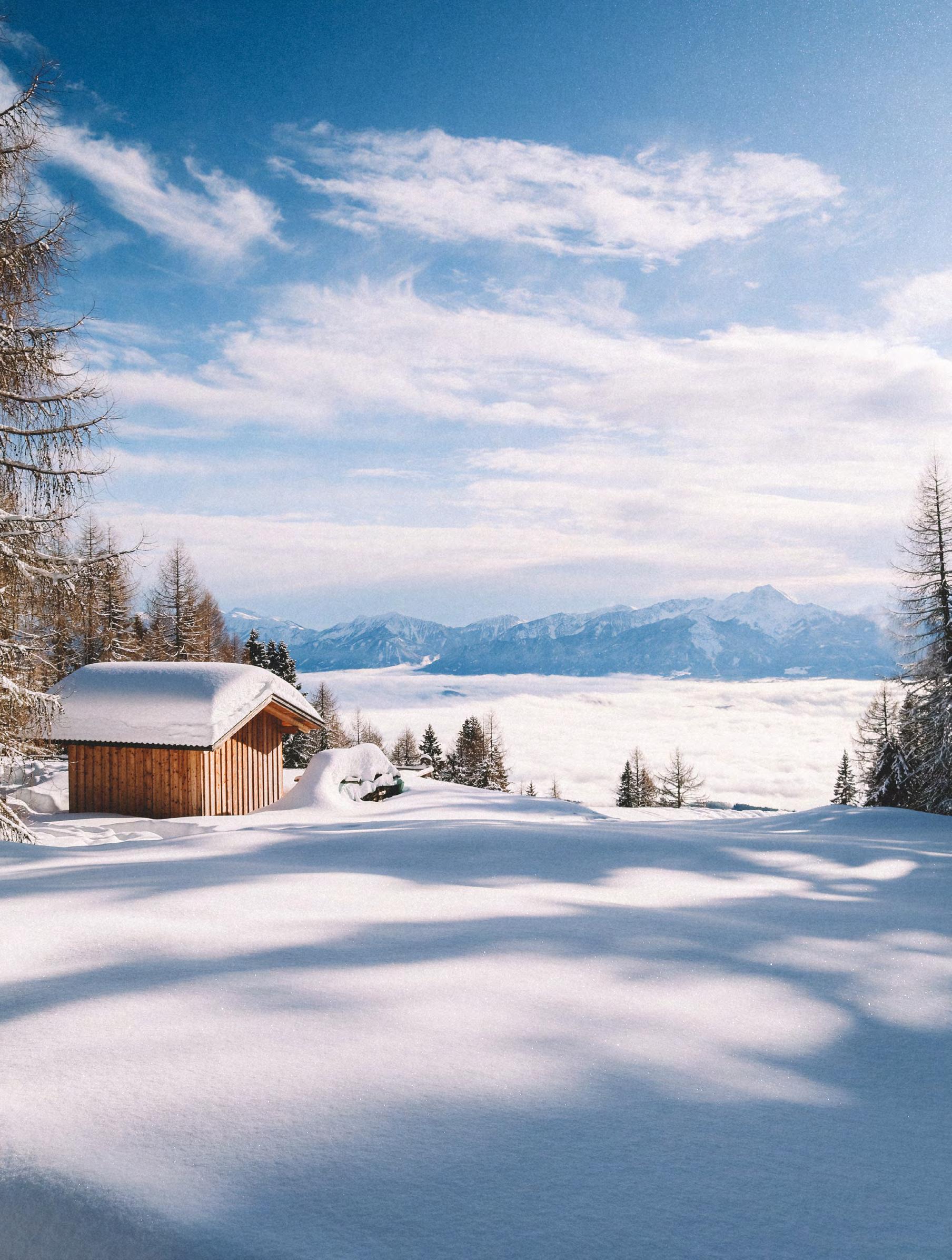
5 When
9
14
16
20 The
22 Nine Reasons Why Your
Enough
24 Sponsor
26 What’s New 27 Cameo’s
JUST FOR FUN
29 It’s a
Building a Bond With
& Students
Winter is More than a Season By Lydia Fairchok
Sport psychology Let Me Help You Boost Your Emotional Intelligence to Uncover Your (and Your Students’) Best Laura King CHt, NLP, Life & Performance Coach
Legal focus Do Your Equine Contracts Really Protect You? Julie I. Fershtman, Attorney at Law
Business matters Not This Year:How to Help Your Students Set (& Achieve) Their Goals ByShya Beth
Importance of Good Spectatorship By Didi Arias
Horse Needs
Copper By Janet Forster
Spotlight
cauldron
By Cameo Miller
Winter Wonderland:
Horses
By Shya Beth
When Winter is More than a Season
 By Lydia Fairchok
By Lydia Fairchok
A Florida-dwelling family member sent me a text the week before Thanksgiving: “It’s winter here...the daytime lows are usually around 60 with a blue sky.” It was twenty degrees and snowing in my Midwestern state when I received this missive from the south, so you could say that my uncle and I have different working definitions of the word “winter”. He certainly wasn’t breaking ice on troughs or cancelling any lessons due to wind chill.
Winter is not my favorite season. My state regularly sees subzero temperatures, strong
winds, and just enough snow to panic the general public into buying every last loaf of bread on the shelf. The deep freezes are interspersed with days barely warm enough to make ugly slush out of the snow—and mud. So. Much. Mud. It’s relentless. Our thick clay-based soil oozes and smooshes and clings like no other. Hoofprints become unforgiving ruts that freeze overnight into an ankle-breaking minefield by the next morning. Wheelbarrows can’t cross it. Thrush thrives in it. Boots gain five pounds with every step you take, if you can take a step at all. Sunny and sixty doesn’t sound so bad
compared to my winter, does it?
The funny thing about winter is that we call it the same whether we are in Alaska or Florida, yet we are referring to different experiences. Some of you are shoveling your way out of six-foot snow drifts that make my frozen mud look like a walk on the beach. Some of you are walking on the beach. Winter may have the same name many places, but it certainly doesn’t have the same impact.
This applies whether we are talking about
Winter 2022 | Riding Instructor 5
winter as a season of the world, or as a season of life. Everyone endures periods of “winter” such as grief after death or change, loss of health, broken relationships, or parenting struggles. There are winters of financial hardship, unmet goals, and unrealized dreams. These seasons create different impacts for different people at different times. Just as your position on the globe changes how you feel the weather, your position in life changes how you weather what you feel.
Being a horseback riding instructor is a position that is especially susceptible to the winters of life. The independence of self-employment comes with the anxieties of fluctuating income, unpredictable expenses, and an ever-raging war with work-life balance. The privilege of training horses and riders whom you love and believe in is offset by the pressure to make progress with the two- and four-legged “problem children” of your barn. Your friends are often also your clients, staff, or competitors, which makes it difficult to truly confide in any one person. Your work is not easy to delegate. There is no paid time off, employee assistance program, or sick days. The stalls keep getting dirtier the longer you stay in bed, and oh yeah—no one is filling in for your duties as a parent, spouse, community member, or mentor, either.
All these things have the potential to pile up until you feel like you are underneath an avalanche-load of impossible burdens. To make matters worse, the winter doldrums of running a horse business don’t come with the promise that spring will eventually return. There is no calendar to mark the days, and the season can stretch on for so long that you forget what it was like to have ever seen the sun.
You may not be able to make these figurative winters go any faster, but you can take definitive steps to make them more bearable. Remember that where you are determines the impact of winter. Changing your position in life is rarely as simple as hopping on a plane to the equator, but it offers much more effective solutions.
Have Friends From the “Outside”
Friends can be a struggle in this line of work because you often share professional and personal relationships with those in your closest confidence. A lifelong friend may compete in the same circles or offer the same services to their own clients. Even a spouse or adult child may be a business partner or deeply embroiled in the daily doings of your work. Most of the time this is great; sometimes it isn’t.
Eliminate Comparative Thinking
Remember when we heard about each other’s lives in face-to-face conversations and letters, not threads and posts? When audiences were smaller, authenticity was a lot easier to come by. Now our social media newsfeeds are filled with an endless reel of awesome vacations, amazing holiday feasts, and fantastic spouses who just received a promotion. Even the “real life” posts of muddy dogs and messy children have an air of humble-brag about them. It may not be the poster’s intent, but the very nature of social media is to showcase carefully curated snapshots. This breeds comparative thinking and the feeling that we are not measuring up to a standard that doesn’t actually exist. How do we break the cycle? Log out of Instagram, set a timer to cap your scrolling—do whatever it takes to free up your mind for your own life without pitting your lows against everyone else’s highs.
Keep all of your healthy relationships as alive and open as possible, but seek out people who have absolutely no overlap with your professional life. Then lean on those friendships. Outside friends don’t have to be completely removed from the horse industry, but they should at least have a different exposure. You need an outlet who doesn’t interact with your people so you can process problems involving your people without gossiping. Outside friends offer perspective, support, and a safe zone without trespassing on professionalism. This connectivity is essential for handling the winter storms of life.
But what if it isn’t other people’s successes that are tripping you up? Minimizing your problems because they are small compared to others’ might seem noble on the surface, but watch that it doesn’t become misplaced justification for leaving your own issues on the back burner. Wouldn’t it be silly if someone in Ohio refused to put salt on their icy sidewalk because they were too busy being concerned that Canada got more snow? This is exactly what happens when we fret over someone else’s problems as an excuse to avoid facing our own, or when we let concern for another overwhelm our ability to care for ourselves. Your winter isn’t any warmer just because someone else’s is colder, and you cannot care for your loved ones without also caring for yourself. Don’t let comparative thinking trick you into hazardous living.
Preserve Your Breathing Room
Experts on surviving avalanches emphasize the importance of oxygen. Once the avalanche settles, the snow compacts and becomes like concrete, making it virtually impossible to move. Avalanche victims are
Winter 2022 | Riding Instructor 6
“
Log out of Instagram, set a timer to cap your scrolling – do whatever it takes to free up your mind for your own life without pitting your lows against everyone else’s highs.
”
urged to immediately clear a pocket of air around their face, and to expand their chest with a deep breath to make the area around their rib cage as large as possible. Being buried under literal tons of snow is a pretty bleak situation, but preservation of breathing room is the first indicator of survival.
In the same way, take inventory of the places in your life where you currently have a little breathing room. Is there one evening a week when you have a break from the kids while they are at an extracurricular activity? A thirty-minute gap between classes? Find the margins and do not give them up. Even if the wiggle room is a matter of minutes, this is your time to breathe or catch up on a little bit of the backlog. Do not feel guilty about saying no to things that would take this time away from you. You need it to survive.
Do Possible Things in Probable Ways
Most plans for alleviating stress involve some kind of prioritization, but making a to-do list is only helpful if you are going to actually do the things on the list. Otherwise they are just one more way to beat yourself up for not accomplishing everything you need to do. Go ahead and make a list of everything you wish you could accomplish, but then revise it to include only things that are actually possible. (Hint: these are things that depend only on you, and are therefore within your sphere of control.) If there are things that are not possible, see if there are preliminary steps that would move towards making them possible, such as buying the right tools.
Once you have a list of possible things, narrow it down further to probable things. It may be possible that you would deep clean the tack room, but if it isn’t probable that you will follow through on that action then take it off the list or break it into smaller components. Perhaps it is probable that you will throw the saddle pads in the wash or put up some new hooks for bridles. Good job!! This isn’t the whole task, but it is some
of the task and for today, some is better than none. Maybe tomorrow you will do a little more.
Honesty is important for this part, because sometimes we reach a place through grief or overwhelm where it is difficult to find motivation for much of anything that is not driven by necessity. Every bit of extra is an accomplishment and should be treated as such. You would celebrate small successes for a student or horse; do it for yourself. Hang those bridles on the new hooks, fluff those clean pads, and say “Self, you did a fine job with that!”, because you did. Then leave the rest for another day, because for now it is enough to chip away at the probable parts of possible things.
Use All Available Resources
Depending on where you are on the face of the earth, surviving the winter requires different accommodations. For some it may require daily blanketing, moving horses to a different state, or trucking in hay. For me, it means heated water buckets, modified turnout schedules, and increasing the budget for feed and bedding. This winter I am also trying a new slow-feeder system to stop my hay from blowing away or being swallowed by the mud instead of by the horses.
Depending on where you are in life, surviving the “winter” requires different ac-
commodations. Some winters may require more work to overcome financial hurdles, or less work to spend time on personal issues. My most recent seasonal modifications have included carefully guarding my work-life balance, relying on set schedules, and learning about new ways of thinking in order to overcome bad habits from the past. Some winters require professional help (yes, I mean consultation with a counselor, qualified life coach, or doctor), and others can be shoveled away with a little help from your friends. You would never expect to go through a physical winter without proper equipment, so why would you expect yourself to endure a figurative winter with anything less?
Winter isn’t anyone’s favorite season for life, but keep your head up because all seasons eventually come to an end. When you can’t change your season, you can change yourself. If you can’t change yourself a lot, you can change a little. Make use of all available resources, and don’t be ashamed to ask for some help digging yourself out of the snow. You deserve every advantage you can have, and your winter is always worth working through. Whatever you do, my friend, don’t give up. We are counting on you to be there in the spring.
About the author:
Lydia Fairchok is certified in Recreational Riding Level 1, and lives and teaches with her three horses in Central Indiana. Lydia segued from a full time instruction career to the field of public safety in 2014 and continues to teach a small number of students while working as a police officer and 9-1-1 dispatcher.
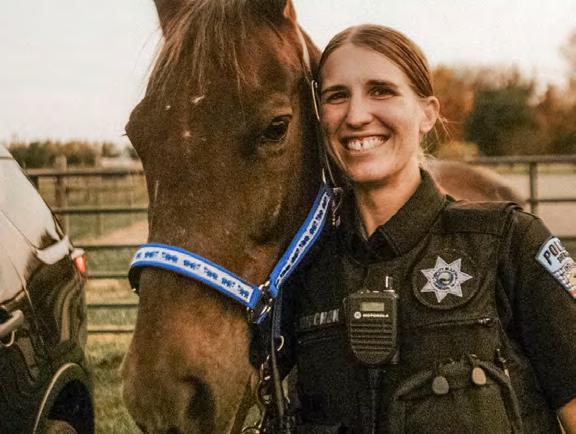
Winter 2022 | Riding Instructor 7
“
You would celebrate small successes for a student or horse; do it for yourself. ”


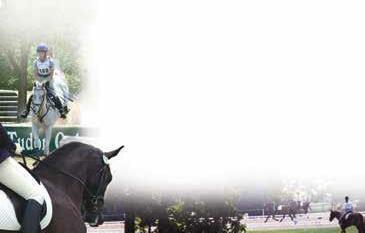







Winter 2022 | Riding Instructor 8 90 YEARS OF EQUESTRIAN LEADERSHIP williamwoods.edu/EQS 573-592-4221 | admissions@williamwoods.edu Careerfocused curriculum On-campus equestrian center Center for Equine Medicine Markel® has you covered Purchase liability insurance online today! An accident that happens during your lesson is a threat to your career, business and assets. We know you are busy! It only takes a few minutes to protect you and your business by applying online for a Markel equine liability insurance quote. • Credit for ARIA certified instructors. • Up to $1,000,000 liability limits. • Coverage applies on and off premises. horseinsurance@markel.com +1.800.446.7925 Markelhorseandfarm.com /MarkelHorse Official Insurance Supplier of The American Riding Instructors Association Products and services are provided by one or more of the insurance companies under the Markel North America Insurance Group and policyholder services are provided by the underwriting manager Markel Service, Incorporated, national producer number 27585. Terms and conditions for rate and coverage may vary. Markel is a registered trademark of the Markel Corporation. ©2021 Markel Service, Incorporated. All rights reserved. Liability • Mortality • Farm owners • Care, custody & control • Excess liability Moving? Don’t miss a single issue… Phone or e-mail us with your new address. 603-605-5275 aria@riding-instructor.com www.riding-instructor.com Official Publication ofTheAmericanRiding Instructors Association Winter 2022 Equine Affaire Inc. 2720 St. Route 56 SW | London, OH 43140 (740)845-0085 equineaffaire.com North America’s Premier Equine Exposition & Equestrian Gathering APRIL 13-16 COLUMBUS, OH Ohio Expo Center The 2023 Equine Affaire offers horse people of all disciplines, all breed persuasions, and all skill levels unparalleled opportunities to learn, shop, network, and celebrate the horse!
Let Me Help You Boost Your Emotional Intelligence to Uncover Your (and Your Students’) Best
 Laura King CHt, NLP, Life & Performance Coach
Laura King CHt, NLP, Life & Performance Coach
What if I told you that the only thing standing in your way of being the best trainer you can be, while guiding your students to their peak performance level, is your own mind? And what if I told you it’s EASY to change the framework of your mind? Well, it is but you need the right tools and the know how to use them to achieve it.
It’s been proven: emotional intelligence can make you more confident, knowledgeable,
poised, committed, and happier and the snowball effect on your students can have profound, positive consequences. As a riding instructor, you have a unique leadership position to demonstrate emotional intelligence and the maintenance of a balanced life. You have the power to become a role model and to change your life, your teaching, and your students’ learning and I’m here to help you – for free.
Read on as I explain emotional intelligence and some steps to take to achieve it. Then, I’ll reveal a link to my FREE online training. No strings attached - it’s my gift to you!
My course, “Emotional Intelligence for Trainers & Coaches,” contains videos, self-hypnosis MP3s, and a wealth of reading materials to facilitate your journey as a top-notch trainer. I’ll explain how hypnosis, Neuro-linguistic Programming (NLP), and
Winter 2022 | Riding Instructor 9
Sport psychology
the right mindset will get you exactly where you need to be. I’ll help guide you toward achieving your equestrian trainer goals –and don’t be surprised if your newfound confidence, knowledge, poise, commitment and ease in your day-to-day practices spill over into all facets of your life. You are more than capable and you are worth it!
What IS Emotional Intelligence?
Emotional intelligence (EI) is the capacity to be aware of, control, and express one’s emotions, and to handle interpersonal relationships judiciously and empathetically. Those with EI are excellent listeners, they are proactive rather than reactive and they are often good in a crisis – all traits that help them get ahead. Emotional intelligence has been associated with an improved overall feeling of well-bring, a higher quality of life and increased job satisfaction. But where to start on the path toward emotional intelligence? The journey begins with self-awareness.
• Self-awareness is your ability to accurately recognize your emotions as they happen and to understand your general tendencies in responding to different people and situations.
• Use the awareness of your emotions to choose what you say and do to positively direct behavior. This is self-management.
• Become empathetic to others and how they are coping with stress and uncertainty. Recognize their reactions for what they are and why they are happening. This is social awareness.
• Then, use your self-awareness, self-management and social awareness as tools to guide you in how you relate to others.
Sixteen Techniques for Handling and Increasing Emotional Intelligence
1. Recognize Your Feelings
Become mindful of and identify your emotions and reactions.
2. Be Observant
Be aware of your emotional state and self-reflect. It may help to write down what you learned.
3. Explore the “Why”
Ask yourself why you are reacting in a certain way. What’s different? What are you dealing with that you haven’t recognized or considered?
4. Stop Negative Personalization
Avoid personalizing others’ behaviors. For example, you conclude the judge ranked you low at the show because she doesn’t like you or your horse. Realize that this negativity is not helpful and resolve to change your thoughts.
5. Select Your Situation
Avoid circumstances that trigger unwanted emotions. For example, there is a fellow trainer you find annoying. Instead of spending your time fuming about her, figure out how to have the least amount of contact and avoid a potentially negative situation. Another example is that running late causes you anxiety. Try leaving 15 minutes early so that traffic, pedestrians or disobedient horses don’t anger you.
6. Avoid Reacting Right Away
Take a moment; breathe, calm your mind, and reflect.
7. Utilize Active Listening Skills
In conversations, emotionally intelligent people listen for clarity instead of just waiting for their turn to speak. They make sure they understand what is being said before responding. They also pay attention to the nonverbal details of a conversation. This prevents misunderstandings, allows the listener to respond properly and shows respect.
8. Change Your Response
Direct your thoughts to something that will calm you: the ocean, the mountains
or spending time with your friends and family. Remember, you are in control of you. You might not feel like being calm at first, but staying calm is a gift to yourself.
9. Blow the Emotion Away
Find a quiet place to disconnect for a moment and breathe deeply, slowly and completely. Visualize the emotion. Then… shrink it. Imagine the emotion becoming smaller and smaller until it is so small that when you hold it in the palm of your hand, you can barely see, feel, smell or hear it. Then… blow on it once and send it off into oblivion never to return.
10. Stay Cool and Manage Stress
Go easy on yourself. Accept that things won’t always be perfect. Remember, you cannot control everything.
11. Practice This Breathing Technique for Stress, Anger or Anxiety
Find a quiet place and try to empty your mind. Breathe in deeply for five counts, hold your breath for five counts and then exhale for five counts. Repeat five times. Remember, paying attention to your breath helps block negative triggers.
12. Try the Cancel Technique
When you catch yourself thinking negative thoughts, stop and say the words “cancel”, “erase” or “delete.” Then, replace that negative thought with a positive one. Or, think of a purple elephant. You can’t think of a negative thought if you are thinking about a purple elephant!
13. Be Proactive, Not Reactive
Consider that you have options when it comes to handling the situation.
14. Learn From Your Mistakes
Reflect on the situation and how you handled it. Determine your strengths
Winter 2022 | Riding Instructor 10
and weaknesses in your response. How can you improve?
15. Maintain a Positive Viewpoint
Visualize and think about how to respond positively instead of negatively. Embrace change instead of resisting it. Remind yourself of all the positive things you have accomplished. Give yourself credit for handling situations in a calm and professional manner.
16. Bounce Back from Your Mistakes
Take a step back and realize you are only human. Forgive yourself. Consider why the mistake happened and, if possible, make it right. If you are unkind to yourself, apologize to yourself. How could you have behaved differently to realize a positive outcome? Practice it in your mind to create a positive habit on how you want to change your behavior next time.
17. It’s a Lifetime Process
Understand and remember that emotional intelligence is something you develop over time and requires continual improvement; it’s very much a lifetime practice.
Remember that we are handling situations in new and uncharted territory but, with these techniques you can create positive ways to handle the stress to realize your own emotional intelligence.
What You’ll Learn in My Free Online Course
When you access my course, “Emotional Intelligence for Trainers & Coaches” via the link below, you’ll have access to tools and tips to guide you on the journey toward EI. You’ll learn about the brain, and the conscious and unconscious mind.
You’ll learn the natural laws of the mind including the importance of thoughts and the power of your imagination, your habits, your attitude and your gratitude.
I’ll introduce you to Neuro-Linguistic Programming, which I call the owner’s manual to your brain. NLP is the study of excellence, the study of success and the science of achievement. With NLP you can learn faster than before, master your emotions more effectively, think more clearly, concentrate better, achieve peak performance, and enjoy riding more than ever.
You’ll also explore self-talk; the process by which you observe the thoughts going through your head, become aware of them, name them. Thought awareness is the first step in the process of eliminating negative thoughts. When you challenge your negative thoughts, you can make them disappear. We’ll focus on positive thinking and affirmations. After all, mistakes are only hiccups, and we can make hiccups go away!
We’ll discuss learning styles, emotional data, and burn out. You’ll learn about hypnosis and why you need it.
My Promise to You
As a trainer, you drive the force of everything you do from what you’ve learned. I’ll help you make the changes you want so you can change unwanted behavior and change the way you communicate. I’ll help you develop the art and skill of communicating
more effectively and to be the best trainer and rider you can be. You will handle your clients and students better, you’ll decrease your stress and tension, you’ll feel happier about yourself and be more aware and alert in your teaching. You’ll be more relaxed and feel a sense of peace in your ability to effortlessly train and teach your students and to enjoy your career.
Ready to Get Started?
Go to laurakingschool.thinkific.com choose the Emotional Intelligence For Trainers & Coaches course and use code: WinterFreebie

Need help addressing your challenges or achieving your goals? Sessions available in-person, via Skype, or by phone.
Products: www.summitpress.net Sessions: www.summithypnosis.com Email: SummitHypnosis@gmail.com Phone: 561-841-7603
About the author:
Laura King is the Director and Founder of Summit Hypnosis and Wellness and is a Certified Hypnotist, NLP Practitioner, Life Coach, and Sports Performance Coach. Laura has written and published several books and workbooks, including ”Power To Win” for equestrians and “Perfect Enough,” a guide to help you evaluate your perceptions and experiences around vital areas of your life.
Winter 2022 | Riding Instructor 11
“
When you challenge your negative thoughts, you can make them disappear. ”
Equestrian Studies
Ellen Erchul ’19 Assistant Trainer, Grey Ridge Farm, Versailles, Ky.
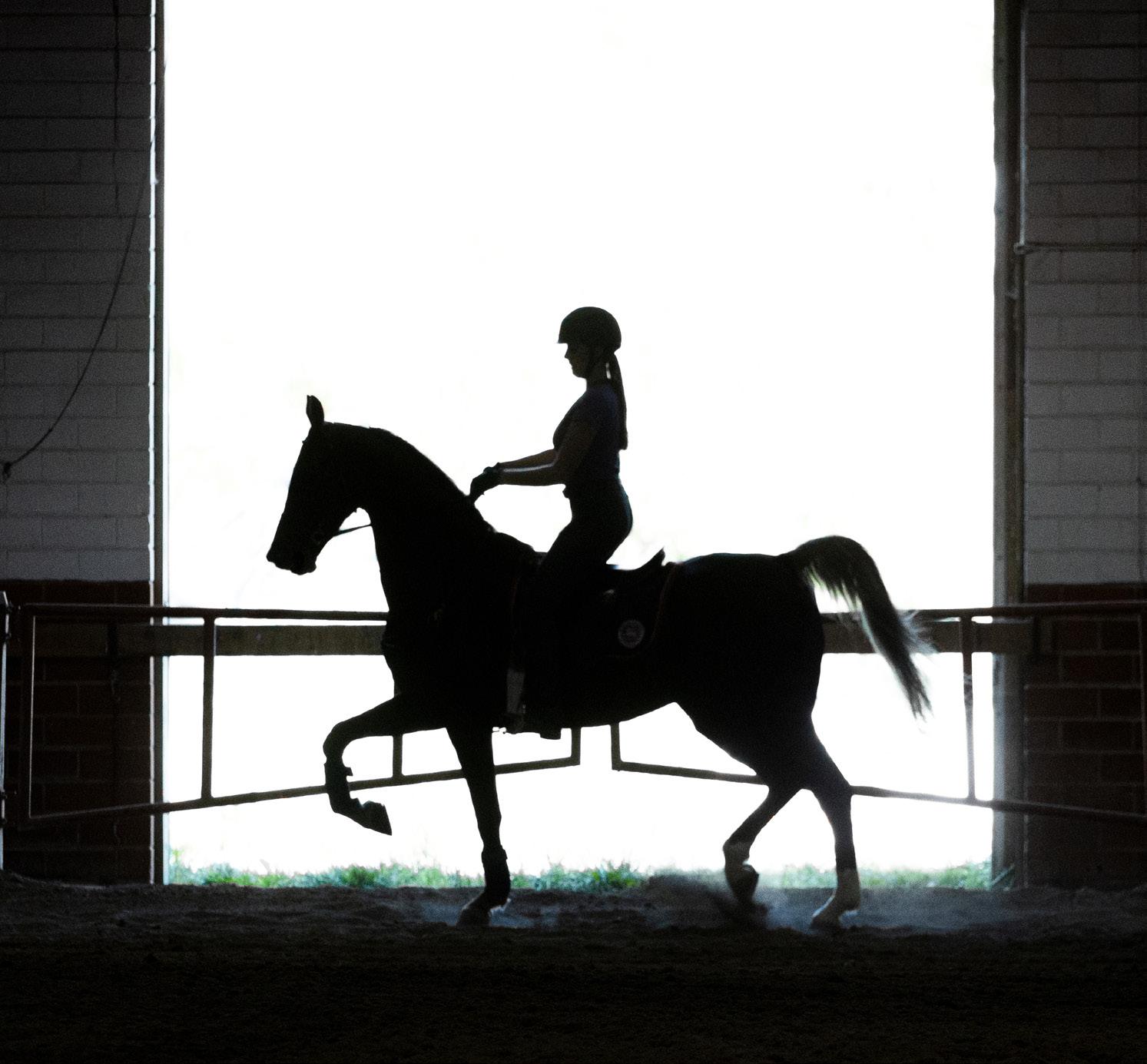
Winter 2022 | Riding Instructor 12 (573) 876-7207 | stephens.edu | apply@stephens.edu Huntseat, Saddle Seat, Western and Driving Four Disciplines, One Family
equine
equestrian for their
“ ”
The
program is so incredibly unique, and there is nothing that will prepare an aspiring
future better than Stephens!
Did you know…
There are lots of omega-3 sources, but they’re not all equally effective. Plant-based omegas, like flax, only contain the short-chain ALA fatty acid. This immature omega-3 doesn’t have the same anti-inflammatory power as the long-chained EPA and DHA from fish.
For the greatest potency, choose a fresh equine fish oil, like Wellpride®. It provides a high dose of EPA and DHA for the greatest anti-inflammatory benefits. You’ll see the clear difference in your horses’ breathing, performance, and coat.
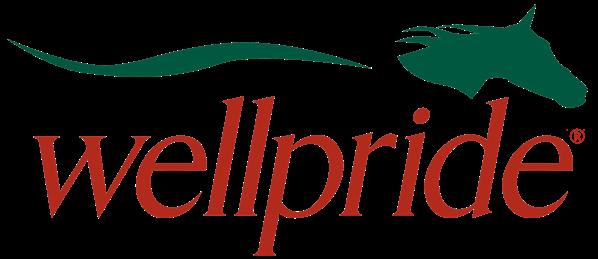

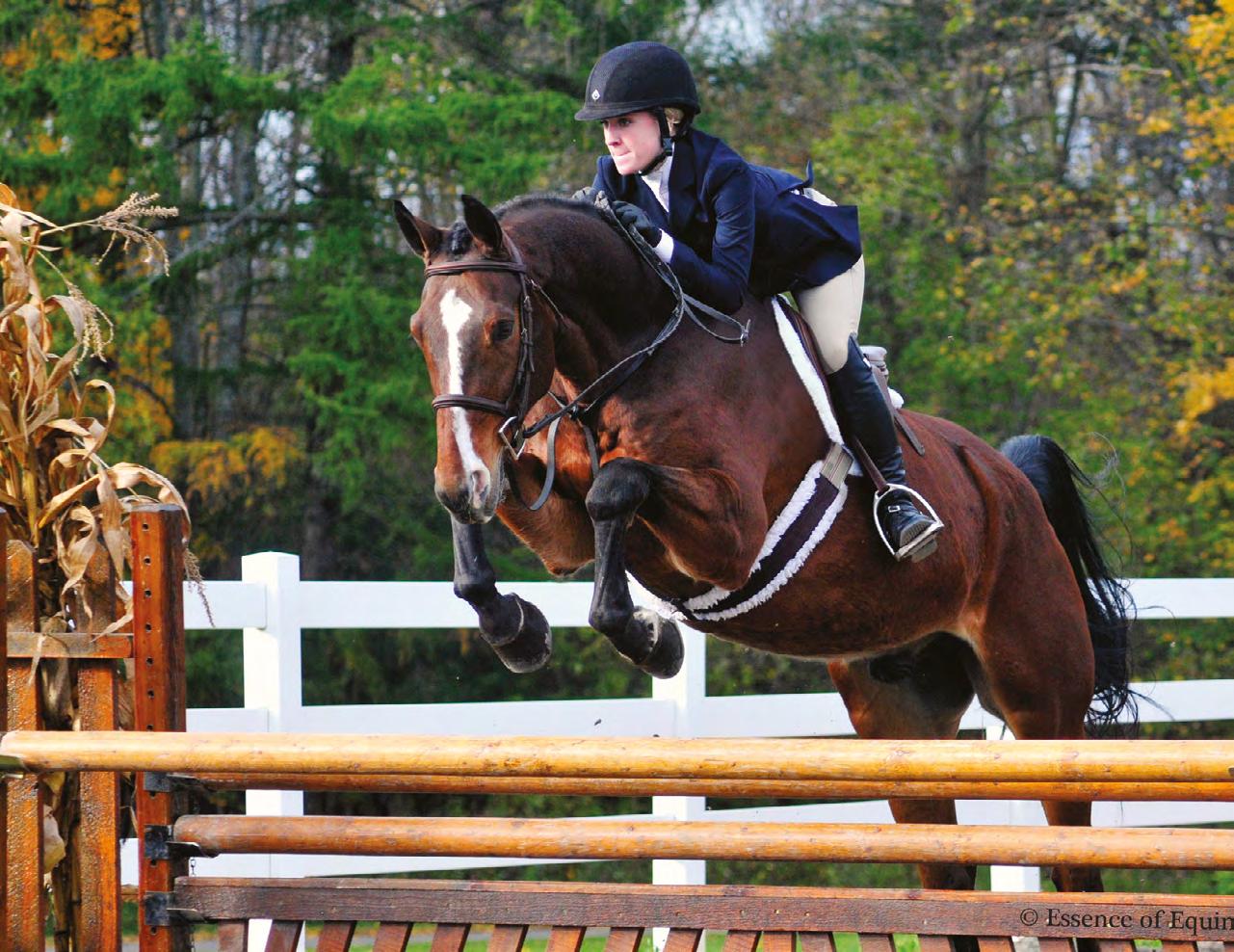
To learn more, visit wellpride.com or call 941.485.4400

Winter 2022 | Riding Instructor 13 Cazenovia College, Cazenovia, N.Y. 13035 www.cazenovia.edu 1.800.654.3210 • Nationally ranked team competing in Hunter Seat,Western Horsemanship, Reining and Dressage • Nationally recognized equine business management program • Ranked one of America’s Best Colleges and a top Best Value in the north by U.S. News WORLD-CLASS EQUINE AT CAZENOVIA COLLEGE OUR 240-ACRE EQUINE EDUCATION CENTER
Do Your Equine Contracts Really Protect You?
 Julie I. Fershtman, Attorney at Law www.equinelaw.net
Julie I. Fershtman, Attorney at Law www.equinelaw.net
Equine contracts can be good news or bad news. The good news is that the contracts used in your equine activities – such as waiver/release documents, training contracts, boarding contracts, leases, and sale contracts – can potentially prevent legal disputes from occurring. The bad news is that your contracts might not protect you as well as you expect. Unfortunately, it sometimes takes a legal dispute to discover the shortcomings of your contracts. Careful advance planning, however, can improve your chances of success.
This article discusses some legal disputes people have encountered with their equine industry contracts, with the goal of helping you avoid them.
Waiver/Release Documents
Problems
Years ago, I defended a trail riding stable in a lawsuit brought by an injured customer. Before each ride, the stable required everyone to sign its waiver. The problem was, despite the word “waiver” in the document’s title, the docu-
ment was not a waiver because it failed to include the most fundamental language where the signer would agree not to sue (lawyers call this “exculpatory language,” and states can differ as to how it should be worded). The stable’s waiver proved to be unenforceable, and we proceeded to a one-week jury trial. Though we ultimately won the trial, the case might not have been brought at all if the stable’s waiver included proper exculpatory language.
Another suit I worked on involved an accident during a riding lesson. A woman fell from a school horse, requiring surgeries and rehabilitation. She sued the stable. The problem was, the release she signed years ago only specified that she was signing in her capacity as parent for her son, the riding student at the time. Nowhere did the document state that she was signing for herself, individually, and releasing the stable.
Solution
If your state enforces waivers/releases of liability (and cases exist in almost every state in which courts have been willing to do so), here are some ideas:
• Make sure your waiver/release complies with the applicable state law. The form you found online may not.
• Make sure your waiver/release document includes legally valid exculpatory language.
• Identify who is signing the document and who the signer has agreed to release from liability.
Boarding Contracts
Problems
I defended a boarding stable in a lawsuit filed against it by a horse owner whose horse was kicked in the pasture by another horse, requiring that the horse be euthanized. The horse owner and the stable disagreed about whether the stable was required to pasture the horse in an individual paddock, away from other horses. The boarding contract was silent on the issue.
In another case, a boarded horse was severely injured when it ran into a tree in the pasture. The horse’s owner threatened suit, but the stable insisted that it was protected by the boarding contract’s liability release clause.
Winter 2022 | Riding Instructor 14
Legal focus
Unfortunately, that clause only applied to people who might be injured, and it said nothing about the stable being released if a boarded horse was injured.
Solution
Here are some general ideas for boarding stables to consider with their contracts:
• Boarding contracts offer stables a great opportunity to describe services they provide in exchange for the boarding fee. For example, the contract can specify number of feedings per day, amount of hay or free-choice hay that horses will receive, and whether daily turnout is provided, whether turnout is in individual paddocks or group pastures. To allow for extra requests from boarders, stables can consider providing a list of optional extra services and a schedule of fees for them.
• Horse owners who have special requests can consider writing those requests into the boarding contract, such as a request that the horse receive an individual paddock.
• Stables can include within their boarding contracts a liability release pertaining to the boarded horse (where allowed by law and in compliance with state law).

Leases
Problem
A contentious equine lease dispute years ago involved a high-caliber show horse that was qualified to compete in a major championship show. The problem was, that show was scheduled to take place after the lease expired. The lessee (the one who had a right to use the horse through the lease) wanted to extend the lease term to allow that competition. Standing in the way was the fact that the lessor already had a new lease, and the next lessee was waiting for the horse.
One of the most heated disputes that equine leases can generate involves the leased horse sustaining an illness, injury, or
lameness during the lease term. Who pays for the horse’s care? When do the lessee’s payments stop? Can the lessee terminate the lease because the horse cannot fulfill its planned use? Can the lessee receive a refund? Without a lease agreement addressing these issues, legal battles can occur.
Solution
Here are some general ideas to consider for equine leases:
• Be careful when you set the lease term. Some are month to month, which self-renew for an additional month unless sooner terminated by either party. The parties may like this flexibility, which allows the lease to end with 30 days’ advance notice, especially if the horse is a poor match for the lessee. But if the horse’s planned use extends to a particular event, show season, or show, lessees should seriously consider entering into leases for a minimum duration; with negotiation, sometimes leases can provide an option for early termination.
• The lease contract can address what happens if the leased horse becomes unsound or unusable for part of the term. Typically, lessees want the lease cancelled when that happens, with refunds. By comparison, lessors may want lessees to pay for the horse’s ongoing care – especially if lessees or their trainers are blamed for causing the problem. With differing interests on the issue
and potentially thousands of dollars at stake, the parties can discuss this issue before they sign the lease. Also, lessees may want to learn about the horse’s health history before the lease agreement is signed.
• Leases can also address the lessee’s option to buy the horse, sometimes for a set price with lease payments applied against the purchase price, or rights of first refusal if the lessor wants to sell the horse.
Conclusion
With equine contracts, details are nothing to fear. Contracts cannot prevent all disputes from occurring, but they can potentially narrow the grounds of a dispute. Plan ahead and protect yourself.
This article does not constitute legal advice. When questions arise based on specific situations, direct them to a knowledgeable attorney.
About the Author
One of the nation’s best-known Equine Law practitioners, Julie Fershtman is a Shareholder with the law firm Foster Swift Collins & Smith, PC, in Michigan. A lawyer with 36 years of experience, she has handled cases in 20 jurisdictions nationwide and has tried equine cases before juries in 4 states. She is listed in The Best Lawyers in America and Super Lawyers Her speaking engagements span 29 states. Her newest book is “Equine Law & Horse Sense,” published in 2019 by the ABA. Written for non-lawyers and lawyers, this book received 4 national book awards. Find it on Amazon and look for the horse on the cover. For more information, visit www.equinelaw.net

Winter 2022 | Riding Instructor 15
Julie I. Fershtman, Attorney at Law
Not This Year: How to Help Your Students Set (& Achieve) Their Goals
 By Shya Beth
By Shya Beth
Say your student wants to be a top-level athlete, traveling the world and competing at the best locations in the world. Or perhaps wants to be an amateur weekend warrior, doing well in a few shows each year. Both have different targets that require different milestones, and both need a training program custom fitted to their strengths, weaknesses, financial abilities, horses, time commitments…and so much more.
It’s important to plan to have a one-on-one meeting at the beginning of the year with your student, discussing their goals and plans for the coming year and show season—but don’t leave it at that. Like most things, everything looks fresh, exciting, and motivating at the beginning of January, and by early February…then the novelty of the new goal or resolution wears off, and you end up sliding back into old habits.
Paint A Picture
No, not literally. You need to come up with a training plan that doesn’t just look good on paper, but that effectively translates to real-world results. Coming up with a training plan means more than just training your student once a week and planning on what shows to attend. You and your student needs to decide on relevant, attainable, and measurable goals.
Winter 2022 | Riding Instructor 16
Business matters
If the goal is simply “I want to do good at the next horse show” there is no real way to measure that goal’s success and what to train for. That is the big-picture goal. In order to get to the big picture goal, there are medium and smaller goals that need to be planned and achieved in order to get to the big picture.
If the goal is “I want to place well and be consistent during this show season,” “move to the next competition level” or “Qualify for the finals” that is the big picture goal. From there, you and your student can plan on weekly, monthly, and quarterly goals. It’s important to include a time element for the goals that can allow for it. If a goal is to learn how to change strides, setting an appropriate amount of time needed is a good way to make sure new things are learned effectively.
Plan it Out—Effectively
We’ve covered the big picture goal—now it’s time to go over the parts that make the big picture goal achievable.
Encouraging your students to keep a riding journal or an online planning/training management platform is something that not many barns do, but it is quite a valuable tool. Training will be better when both the instructor and the student have access. Keeping a living training plan means you both can review goals, keep track of each lesson, what was accomplished, and what needs to be focused on improving.
Having a dedicated section on a whiteboard, planning journal or online planning application can be an invaluable tool for keeping focused on the big picture and keeping track of how your student is progressing. It’s easy to get frustrated and not see any results when training, and have your student feel like he or she is getting nowhere.
Having a monthly review and being able to flip back a few pages to a few months ago when your student was having a hard time overcoming a particular problem and seeing how they overcame the issue can show how far they really have come, and how much closer to their goal they are.
Break it Down Into Manageable Bits
Once your students have a clear big picture and monthly plan, it’s time to take it and break it down into manageable bits— namely weekly and daily goals. From each lesson, you’ll be able to hone in and go over with your student different things they need to focus on. Consider it to be “homework” that students can practice on during the rest of the week, and is something more measurable during the next week’s lesson. It goes without saying that as their trainer your key role is assessing where your rider is weekto-week, and giving important feedback on what needs to be changed and improved.
This moves us to the next section—daily goals. From increasing the horse’s suppleness or working on a more engaged hind end to improving the sitting trot or riding form, there is a never-ending list of possible daily goals your student can practice. That does not mean that every ride must have a training goal attached—it’s important to have fun and enjoy the ride!
Keep it Positive & Realistic— Riding Should be Fun!
It’s not all about the awards and prizes. While that can be a huge motivator, the love of the horse and riding itself is what brings us all here in the first place. Make sure your students state their goals in positivity, instead
of coming from a place of fear or negativity. Instead of saying “I’ll work towards not taking any rails down” for a jumping competition, say “my goal is to have a clear round” or “I won’t get nervous cantering downhill in a cross-country course,” replace that with “my goal is to canter smoothly and balanced down the hill to the jump.” You want your students to come from a place of confidence, and that begins in the mind.
Riding is full of ups and downs, wins, and lots of losses. Instilling in your students to value their own personal achievements—cantering down that hill confidently, or jumping a clear round—is just as important as podium placing at the end of the show. As a trainer, you might enter your student into a lighter level class just for them to gain experience, and it’s essential that your students realize that going into the arena the goal is not to win, but to gain experience and further their skills so that one day in the not-so-far-away future, they can win that class.
Shya Beth is a rider, artist writer and all around horse lover based in New Jersey, USA. Whether creating horses in art, riding in the fields on her farm or writing about horses, horses are a huge aspect of her life and inspire her every day.

Winter 2022 | Riding Instructor 17
About the author:
“
Riding is full of ups and downs, wins, and lots of losses. ”
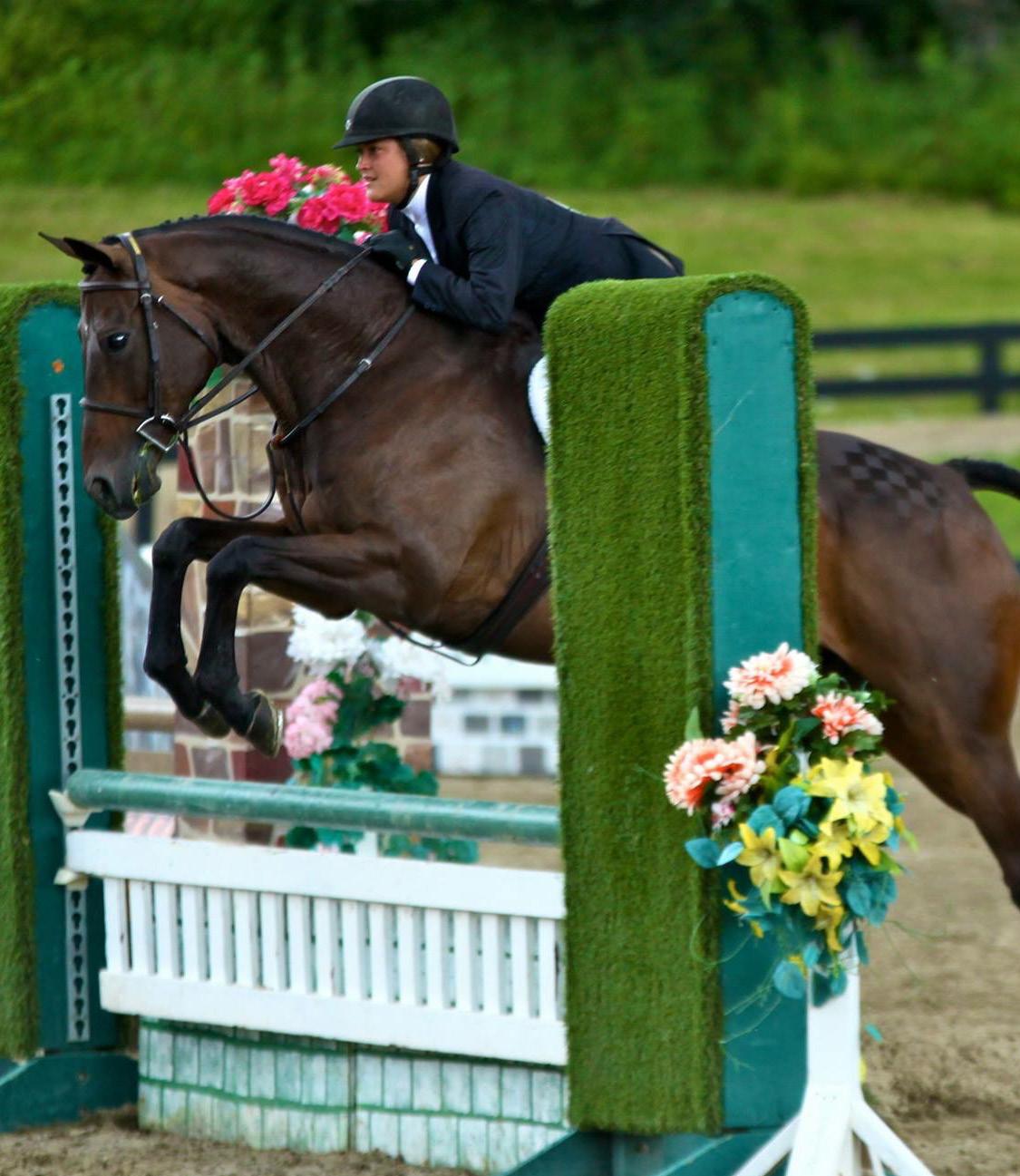
Winter 2022 | Riding Instructor 18 700 East Butler Ave. | Doylestown, PA 18901 p: 800.2.DELVAL w: delval.edu/equine At DelVal, we focus on hands-on learning and real-world experiences to prepare you for success in the equine industry. WE OFFER: • On-campus Equestrian and Breeding Centers • Nationally ranked IHSA and IDA Teams • British Horse Society Testing Center EQUINE DEGREES: Equine Management • Assisted Therapies • Business Management • Instruction and Training • Media and Communication Equine Science • Breeding • Pre-Professional Building Champions
Your E-Mail Address is important - for us and for you!

ARIA communicates primarily by e-mail with its members. Please make sure we have a working e-mail address for you. If you’re not sure, write to us at aria@riding-instructor.com and let us know your current e-mail address.
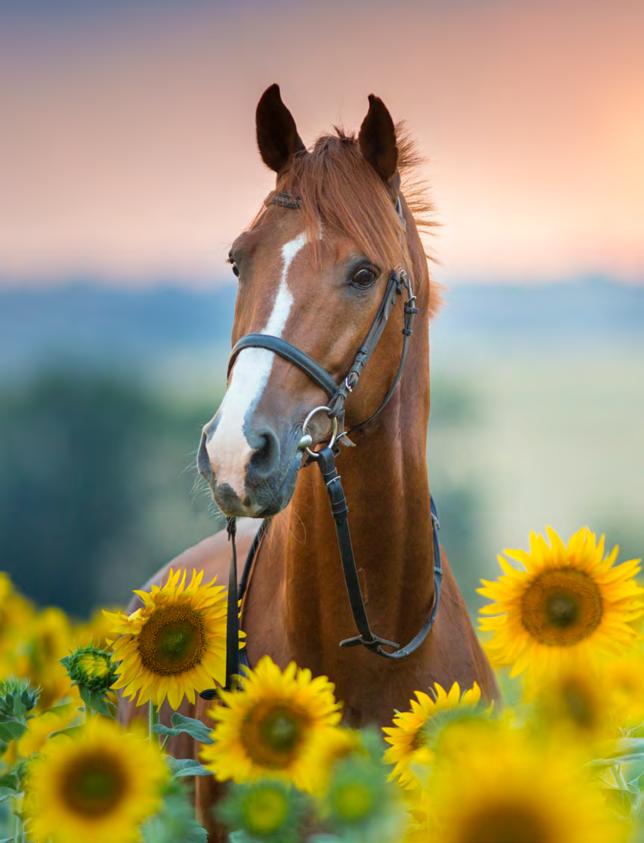
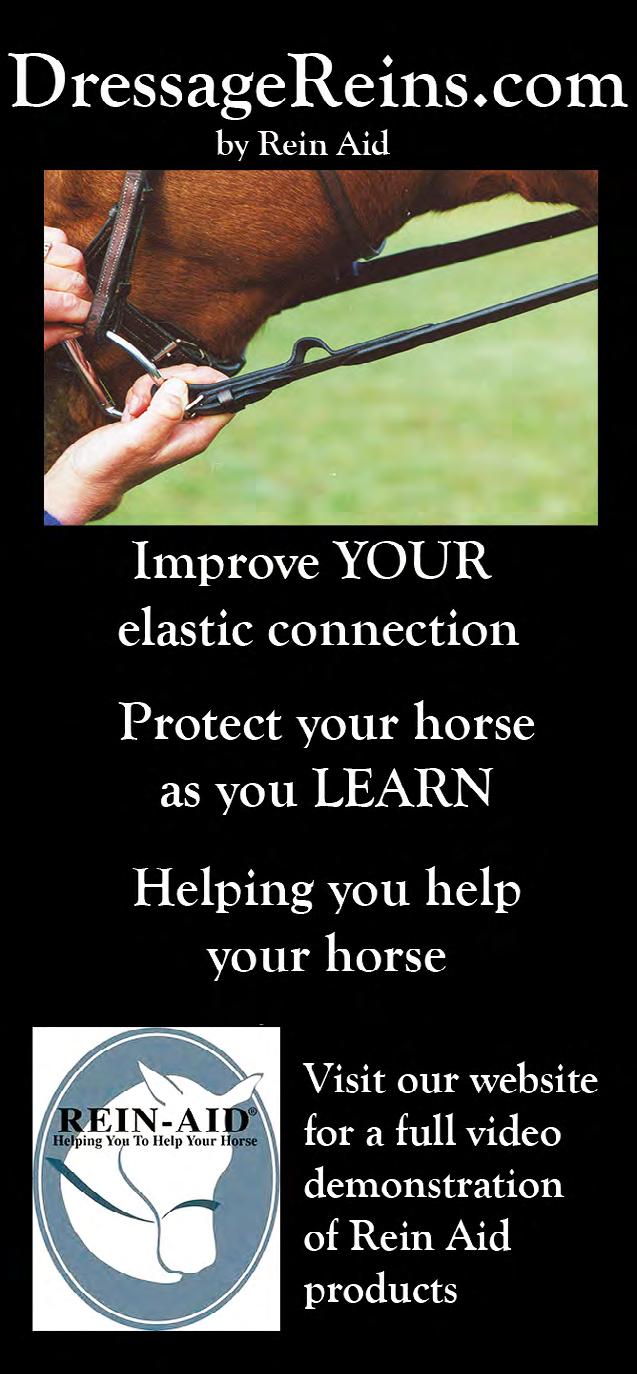
Thanks!
The Importance of Good Spectatorship
By Didi Arias Illustration by author

I´ve written previously on the importance of teaching good sportsmanship, so it feels right to pick up where I left off and bring up the subject from the other side of the rail, the spectator side. In teaching young riders, we recognize the topic of good sportsmanship as an important one, and part of that encompasses how to be a good spectator too.
The benefits of youth participation in sports is clear: exercise, physical health and development, motor skills, etc., as well as being part of a social circle and getting to learn from (hopefully) good role models. Spectators are also a form of “participant”,
and part of any organized sport: their presence spreads interests and shows support. Visible spectatorship helps a sport gain sponsors, as well as bringing in cash to food, drink and merchandise concessions as well as income to the facility where the event is being held. In short, spectators are an integral part of promoting a sport, riding included, and they bring a greater chance of future events being held.
Unless one is on the organizing end of things, not everyone realizes how tied up competition is with money and the huge costs that can be incurred to run an event. Even a small
show at a modest facility can end up with a big outlay, so bringing in both competitors and spectators is of course priority.
I really enjoy taking young students as a group on a “school trip” outing to see what is possibly their first show. Not only can they get great first-hand exposure to a real-life event, but they also get to experience the real-life situations happening around them; in other words, great teaching-learning opportunities. The showground becomes their classroom as well as the venue for a really great day out. Attending a show as a spectator, and not a competitor, frees the
Winter 2022 | Riding Instructor 20
student from the pressure and stress of actually competing, allowing for enjoying the event from the outside looking in and for making important observances.
Most youngsters are generally a wellmannered lot, as spectators go, and if they do act up; it is generally when left unguided. When they band together, things can get a little energetically unruly as they egg each other on to disruptive silliness or nasty mockery. What is worse in my mind is when they mimic the inappropriate behaviour they´re witnessing from others, usually that of un-sportsman-like adults. In recalling how I´ve seen some rail-side, backstage, and hockey rink parents behave, I cringe at the poor role-modelling they exhibited.
But really,the rules to set out for good spectatorship are obvious and simple, though sometimes overlooked. Here is what I focus on with my students:
None of the “Bs”
No belittling, bellowing, booing, banging or obnoxious bragging.
Be polite and try to think nice things first The judge is practicing that too.
Choose words for comments carefully and try to swallow the negative ones People my age were raised with the adage“if you can´t say anything nice don´t anything at all” – and that still holds strong as some of the best life advice today.
Help the student express themselves by refining respectful words to describe what they are observing. “That horse stinks” might be more politely described as “That horse looks like a challenging ride”, and then explain why; moments like this can be good conversational moments for learning.
Show rules are similar to barn rules
Avoid running, climbing, loud noises and the general stuff that upsets/distracts the horses, riders and those around you. Think
In recalling how I’ve seen some rail-side, backstage, and hockey rink parents behave, I cringe at the poor role-modelling they exhibited.
about waiting until a test or round is finished before going in to or out of the seating area to avoid making a noisy disturbance.
Be respectful and show kindness towards others
Whether you like them or not, whether you feel they should have won or not, the “speak to and about others as you would want others to speak to and about you” reminder applies here.
Show general appreciation and enthusiasm for competitors
Only applauding your best friend is kind of stingy, so show your support for others, too – it positively raises the atmosphere.
Respect also extends to the officials
The presiding official at the event is the judge and the one with the full understanding of why a certain mark or award was given and the one with the final word.
Respect also extends to the showground
Though others may drop their paper cups and napkins on the ground, feel pleased to know that yours went in to the trash bin.
Umbrellas Are Shapeshifters
When closed they can usually pass within close range of horses virtually unnoticed, however, when opened, the Monster has been unleashed and it is a whole different
ball game. If you´ve got to use one, stand back and keep it still.
If something out of the rules is witnessed, including an incidence of abuse, it can be taken up officially so report it to your teacher/coach or official.
We´re fortunate that in our horse sport “lager louts” and hooligans aren´t the norm. Absent too is the intense team rivalry and high alcohol sales that can provoke raised aggression such as is prevalent in other sports. Though I´ve seen some heated discussion, I´ve yet to witness fisticuffs at a horse show, though, I´m sure it occasionally happens. Perhaps, as horse people, we generally tend to be a more restrained lot –most likely thanks to the horses that can put us in our places (and on our backsides) so efficiently when we lose our composure.
The good ethical values of good sportsmanship and spectatorship in equine competition promote social values, and that in return, promotes our sport – it’s a nice circle. As I look back at my list above, I smile as so much of this is basic “grandparent advice” on correct behaviour, and I´m very thankful to know so much of that has stuck since childhood. In turn, by sharing this knowledge with our students, we´re kind of “sticking it forward” on them.
About the author:
Didi Arias is a Level 3 ARIA Certified Instructor and national dressage judge and teacher, who resides in Almeria, Spain.

Winter 2022 | Riding Instructor 21
Nine Reasons Why Your Horse Needs Enough Copper
By Janet Forster
Copper is a nutrient that is essential for all mammals. It functions as a cofactor in the activities of many enzymes (proteins that catalyse chemical reactions throughout the body). These enzymes play critical roles in maintaining overall health - organ function, metabolism, growth, detoxification processes, and more.
Here are 9 reasons why horses must have enough copper in their diet:

Copper And Metabolism Of Iron (And Zinc And Manganese)
Copper is an integral member of a group of 4 minerals (Fe/Cu/Zn/Mn) that work in synergy and must be present in the correct ratio with each other for optimal metabolism (uptake) of all 4 to occur. One of these
minerals is iron, essential for red blood cell production amongst other important tasks.
Inadequate copper levels can cause iron deficiency anaemia, even in horses that have sufficient levels of dietary iron. However, excessive iron levels adversely impact copper metabolism, even when there is enough copper in the diet. This causes a copper deficiency (that in turn affects iron metabolism and brings on iron deficiency anaemia).
Take home point: Maintaining the correct ratio between these 4 minerals is critical for overall good health.
Copper Balances High Iron Diets
High dietary iron levels contribute to a range of disorders including liver damage,
laminitis and insulin resistance. It also impacts copper and zinc absorption as mentioned above.
Most forage is (very) high in iron, mainly because iron is abundantly present in soil and water. Given that horses must consume large amounts of forage to keep their digestive system working correctly, it’s almost impossible to significantly reduce their iron intake without starving them! The accepted work-around solution is to increase the other minerals (copper and zinc notably) that work synergistically with iron so the all-important recommended Iron: Copper: Zinc ratio of 4:1:3 is maintained.
However, it should also be noted that horses, unlike sheep and cattle, have quite high upper tolerance levels for iron and copper. Therefore, they can tolerate a ratio of 4-8:1:3-4 for Iron:Copper:Zinc respectively without suffering adverse side effects.
Take home point: Increasing copper and zinc to balance high iron levels is the recommended way to deal with diets excessively high in iron.
Copper And Cellular Energy Production
Cytochrome c oxidase is a copper-dependent enzyme that spans mitochondrial membranes and catalyses the conversion of oxygen to water to produce cellular energy. The copper molecules in the enzyme act as binding sites for oxygen molecules. Insufficient copper in the diet therefore impairs the ability of cytochrome c oxidase to do its job properly.
About mitochondria: these are the power plants of cells. They produce adenosine triphosphate (ATP), the primary source of cellular energy. This energy underpins every single cellular activity that takes place within the body.
Take home point: Horses require enough copper to maintain the cellular energy that keeps them alive.
Winter 2022 | Riding Instructor 22
Copper And Hoof Health
Copper is essential for good hoof health. Along with zinc, it is involved in keratin synthesis. Keratin is a structural protein found in hair and hooves.
Research has found that horses that get enough copper and zinc in the correct ratio with iron and manganese have lower occurrences of seedy toe (white line disease) and less risk of hoof wall separation. They also have better overall quality of hoof growth –less cracking, stronger hoof structure etc.

Take home point: Horses need copper, and zinc, for good hoof health.
Copper Is A Valuable Antioxidant
Copper-zinc superoxide dismutase is an antioxidant enzyme (that contains copper and zinc) that catalyses the conversion of superoxide radicals into hydrogen peroxide so they can be further converted to water by other enzymes. In humans, a version of this antioxidant is found in skin cells where it helps protect skin from oxidative damage.
Take home point: Horses need copper for antioxidant protection.
Copper And Immune Function
Low levels of copper-zinc superoxide dismutase can adversely affect immune system function. Certain types of immune system cells rely on the enzyme to produce hydrogen peroxide (see above point), which is then used to help prevent infection and destroy bacteria. Bacterial conditions like rain scald and mud fever for example may be exacerbated by insufficient levels of this enzyme due to low levels of copper and zinc.
Take home point: I have personally noticed a vast improvement in the skin health of my older horses in particular since balancing their Fe:Cu:Zn ratio correctly.
Copper And Nervous System Function
Nerve cells are covered in a protective sheath of myelin and, you guessed it – copper is in-
volved in producing and maintaining myelin. Copper is also required for norepinephrine production, a neurotransmitter that facilitates communication between nerve cells.
Take home point: Horses require enough dietary copper to maintain good nervous system function.
Copper And Foetal Bone Development
Lysyl oxidase is yet another copper-dependent enzyme involved in extracellular processing of connective tissues ie collagens and elastin. This means that copper is essential for the functional activity of the enzyme, and thus for the development of strong tendons, ligaments, and cartilage.
Inadequate gestational copper levels in mares therefore may be linked to connective tissue problems in their newborn foals. Notably osteochondrosis (OCD), a developmental orthopaedic disease that afflicts as many as 25% of young horses and newborn foals, can be caused by mineral imbalances and a copper deficient diet.
Take home point: Horses require enough dietary copper to maintain strong, functional tendons, ligaments and cartilage, especially in utero.
Copper And Coat Colour
Copper is a core ingredient in the enzyme tyrosinase, which in turn is essential for melanin production. Melanin is the pigment that gives skin and coat hair their colour, and provides protection from harmful solar energy.
A dietary copper deficiency means they can’t produce enough tyrosinase to maintain normal pigment production. The result is usually a dull, faded coat that sun bleaches rapidly. These horses are also probably zinc-deficient as well, although other issues like high worm burdens may also contribute to the problem.
Take home point: Horses fed enough copper should have rich, fully pigmented coats because they can produce sufficient melanin to protect their coats from sun bleaching.

The Final Point About Copper
Adequate copper levels allow enzymes in all cells of the horse’s body to work properly. This improves overall health, coat and hoof condition, energy metabolism, and much more.
Always get a diet analysis done and consult an equine nutritionist for advice before adding individual minerals to your horse’s feed.
Winter 2022 | Riding Instructor 23
About the author:
Janet Forster hails from sunny Perth in Western Australia. During a lifetime spent with horses, she has bred, competed, loved and written about them. She owns a collection of high percentage Tb crossbreds, most of which are palominos and registered Australian Stock Horses.
Sponsor Spotlight
Wintec Saddles
As the world’s favorite synthetic saddle brand, easy-care Wintec saddles can be found in barns across the United States. Your students will feel in-control as the super-soft deep seat of the Wintec Pro Jump provides the perfect level of grip to support their balance without restricting their movement. The rider’s leg will find its natural groove and contact and communication will become effortless. The super-soft panels mold in and around the horse’s muscles, freeing them to fly. Learn more about the entire Wintec jump saddle range at https://wintec-saddles.com and give your students the confidence to soar over any course of jumps.

Wellpride
“My vet says Wellpride® is the only fish oil supplement her clients’ horses reliably eat.”

That’s a quote from Stephanie Church, editor-in-chief of The Horse. Stephanie and her horse Happy tested Wellpride, and chronicled their exciting results for The Horse online.
Before Wellpride, Stephanie and Happy had tried an off-brand fish oil without luck. Happy refused it, and Stephanie had to scrub the bucket many times before he would eat from it again.
If you’re searching for an equine omega-3 supplement, but worry about palatability, try Wellpride. Thanks to its superior quality, it’s got a great taste even picky eaters love!.
www.wellpride.com

Winter 2022 | Riding Instructor 24
Cazenovia College
www.cazenovia.edu
Cazenovia’s Western, Dressage and Hunter Seat team is among the best in the region.

Cazenovia College is a small, co-educational college, located in Upstate, NY, offering a liberal arts and professional studies education with over 35 academic programs. Our 240-acre Equine Education Center is home to the nationally ranked Intercollegiate Equestrian Team and the IACBE accredited Equine Business Management program. Our Equestrian Team is one of the best in the region, with a long history of success at intercollegiate and rated competition in Hunter Seat, Western Horsemanship, Reining and Dressage. The team competes in IHSA and IDA sanctioned events. Our world-class equine facility houses over 70 horses, a large, heated indoor arena, multiple grass and sand outdoor riding areas, and turnout paddocks.
William Woods University
Take the next step in your career at William Woods University!
The online Master of Education in Equestrian Education degree from William Woods will help you gain the field pedagogy skills you need to make the transition from equestrian professional to equestrian educator. The online graduate degree combines the academic excellence and supportive teaching culture of the William Woods equestrian program with the convenience and affordability of a nationally ranked online education program. You will receive quality online instruction through the latest educational technology and collaborate with your peers in an interactive and engaging learning environment. Learn more at williamwoods.edu


Winter 2022 | Riding Instructor 25
Sponsor Spotlight
The E-Pak™
Totally Wireless Riding Instructor Communication
Featuring: Bluetooth Technology, Echo Cancelling, and Frequency Hopping.
[Narragansett, September 15, 2022]—Eartec Co. announced today the E-Pak Equestrian Wireless Communication System.

The E-Pak series are groundbreaking full duplex systems engineered with bluetooth headset connectivity allowing equestrian instructors to communicate with students completely free of wires. E-Pak are compact radios that can be clipped to clothing or tucked away in a pocket, freeing users to concentrate on the lesson at hand. The Lazer-Pro headset connects to the E-Pak without a cable and fits comfortably when worn with a riding helmet. Riders can also pair their own mobile phone earbuds. E-Pak utilizes an Echo Cancelling filter to eliminate your own voice “bouncing back” through the headset. Echo Cancelling purifies E-Pak signals removing echoes and reverberations that can cause communications to become interrupted or even un intelligible. Engineered to perfection, built with precision and excelling in performance Eartec E-Pak wireless systems are uniquely designed to make your riding lessons more efficient, effective and enjoyable. visit: eartec.com/equestrian
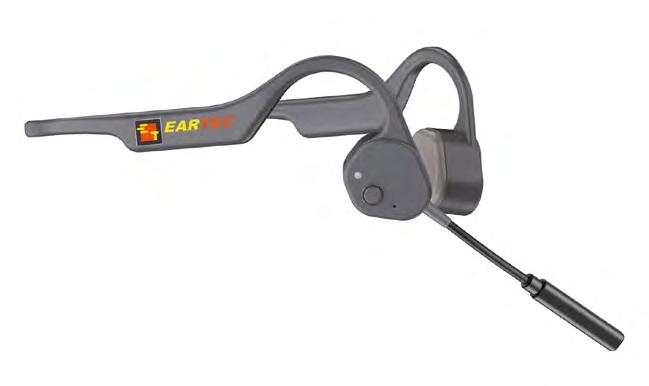
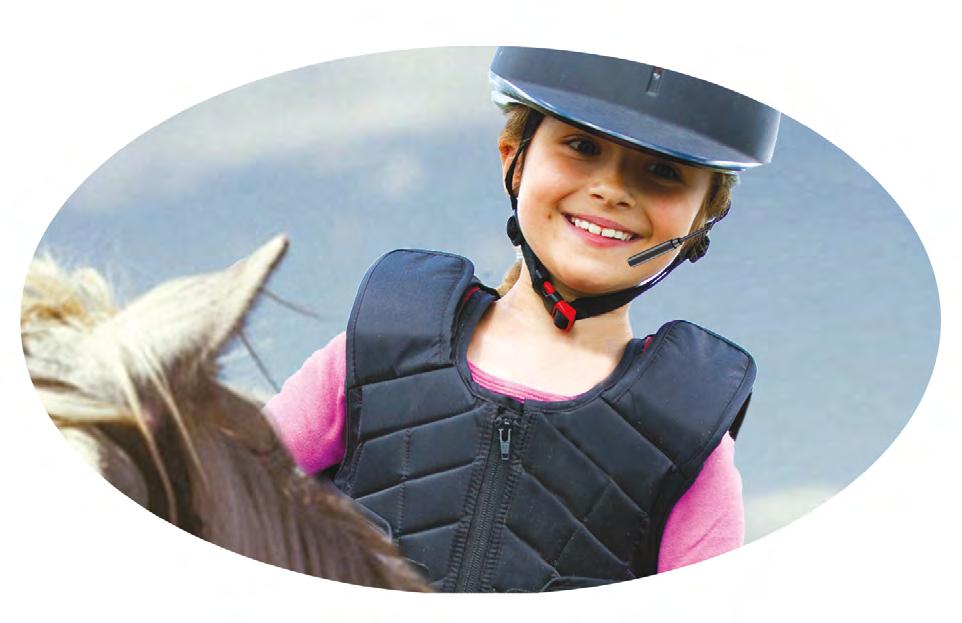
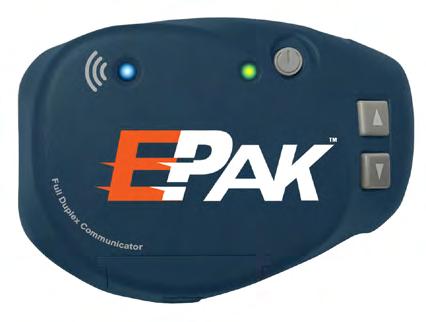
Eartec Co.
145 Dean Knauss Dr, Narragansett, RI. 02882 https://www.eartec.com info@eartec.com


What’s New
… in which Cameo Miller stirs her thoughts and ideas to see what rises to the top.
Think like a proton and stay positive (Picture an atom).
I really don’t mind getting old, but my body is having a major hissy fit.
Camping: where you spend a small fortune, to live like a homeless person.
Teacher? I prefer the term educational rockstar.
I’ve reached the age where my train of thought often leaves the station without me.
I’m going to stop asking ‘How dumb can you get?’ People seem to be taking it as a challenge.
I meant to behave, but there were too many other options.
Not to brag, but I totally got out of bed today.
JUST FOR FUN
By Cameo Miller Illustration by Bethany Caskey
They say laughter is the best medicine. So I thought I’d do something completely out of the norm for me this time. For many years I have been collecting the cute sayings from T-shirts and sweatshirts. The ones that make me laugh, or ones that speak to me in some way. I decided to share a bunch of them with you this time in the hopes that you will also chuckle, laugh, or nod in recognition. I hope some of them bring a smile to your face, and a bit of joy to your heart. ENJOY!
My doctor asked if anyone in my family suffers from mental illness. I said: “No, we all seem to enjoy it.
I disappear into books, what’s your superpower?
I wet my plants (for gardeners).
I can keep my mouth shut, but you can read the subtitles on my face.
If you’re happy and you know it, it may be your meds.
Had a big mix up at the store today. Apparently, when the woman said ‘strip down facing me,’ she was referring to my credit card.
You couldn’t handle me even if I came with instructions.
I’m going to stand outside — that makes me outstanding.
A farmer is a person outstanding in his field.
‘Project manager’ because miracle worker isn’t an official job title (Change to read: barn manager?).
Don’t mess with grandmasaurus — you’ll get jurasskicked.
Sometimes I question my sanity, but the unicorn in the kitchen told me I’m fine.
Hold on, let me overthink this.
THINK. It’s not illegal yet.
I don’t care who dies in the movie as long as the (insert favorite animal) lives.
Crazy cat lady?
I prefer dedicate feline enthusiast.
It’s not hoarding if it’s books (or horses?).
Happiness is a REALLY big fish and a witness.
Life is too short to waste time matching socks.
Since there is only one of me, does that make me endangered or a limited edition?
All we need is love… & LOTS more chocolate.
I speak fluent movie quotes.
WARNING: may start dancing for no reason.

It takes real skill to choke on air, fall up the stairs, and trip over nothing. I have those skills.
If you see me talking to myself, don’t be alarmed. I’m self employed. We’re having a staff meeting.
Just once I want a username and password prompt to say, ‘close enough.’
Day 12 without chocolate — lost hearing in my left eye.
Winter 2022 | Riding Instructor 27
Cameo’s cauldron
Awesome ends with ‘me’. Coincidence? I think not.
Scientists say the universe is made up of protons, neutrons, and electrons. They forgot to mention morons.
Another wine bottle with no genie at the bottom. I’ll keep looking.
You know that little thing inside your head that keeps you from saying things you shouldn’t — I don’t have one of those.
SMILE — it makes people wonder what you’re up to.
The adult version of ‘head, shoulders, knees and toes’ is wallet, glasses, keys and phone.
No, I don’t need anger management, you need to stop pissing me off.
Dusted once, it came back. I’m not falling for that again.
OOPS, did I roll my eyes out loud?
I don’t curse. I speak fluent trucker with a sailor dialect and a construction accent.
I came, I saw, I forgot what I was doing. Retraced my steps. Got lost on the way back.
Now I have no idea what’s going on.
Prayer: the world’s greatest wireless connection.
If I were a bird, I know who I’d shit on.
You can’t scare me, I’m a nurse and I worked through a freaking pandemic.
I tried to be normal once.
Worst minute of my life.
I used to be able to do cartwheels, now I tip over putting on my underwear.
I hate it when I see an old person and then realize we went to high school together.
I ride horses because punching people is frowned upon.
You think I’m sarcastic? You should hear what I don’t say.
Speaks fluent song lyrics.
I did not fall. The ground looked so sad I thought it needed a hug.
Intelligence tests are getting ridiculous — they asked me to fold a fitted sheet.
I don’t like to brag about expensive trips, but I did just return from the grocery store.
Sometimes I wonder what happened to the people who asked me for directions.
I don’t trip. I do random gravity checks.
I’m a multitasker. I can listen, ignore, and forget all at the same time.
I like growing my own food, but I can’t find bacon seeds.
About the Author: Cameo Miller is a Masters-level clinical psychologist and a Level IV ARIA Certified Instructor based in Michigan. She is a member of the ARIA Evaluation Panel and an ARIA National Test Center Administrator.

Winter 2022 | Riding Instructor 28
It’s a Winter Wonderland: Building a Bond With Horses & Students
 By Shya Beth
By Shya Beth
Whether your students have their own horses or ride your stable’s lesson horses, you can bet being at the barn is a highlight of their week. Some will come by every day just to give their favorite horse a carrot and pat while others only come for their weekly lesson, and that’s okay! But what if you could bring your group of students closer together, building not only their trust and friendship but a community of riders centered around your stable and love of horses?
Making your barn into a social center for your students does not mean you need to open a horse-themed coffee shop on the stable grounds, but rather by building stronger connections to you and your business. Besides offering the normal lessons, leases, and horse show support, your students will be more apt
to join your barn and stay with you long term if they feel like it’s their second home…and let’s face it, don’t most horse people refer to the barn as their “home away from home”?
Focus on Bonding
For most students, the majority of their time at the stables is focused on building their skills as a rider on horseback. And while riding is the biggest part of most lesson plans, let’s not forget the other part that makes someone a horseman or horsewoman and not just a rider—horsemanship! Many students these days show up for their lesson to a pre-tacked horse and pop off after their lesson, not to be seen again till the next time. While there is nothing wrong with that, this is creating more riders, not horsemen. It’s important to encourage students
to take an interest not in just the ribbons and prizes, but in the day-to-day horse care and being a well-rounded horseman.
Build Barn Camaraderie
There are many winter activities you can do that require minimal setup that will educate your students and build trust and friendship between them. Besides being somewhere to stable their horse and train, students can find a community and home within the barn with you, other employees, and of course, other students! Regardless of the ages you cater to, there are a host of activities that can be done to include everyone.
WATCH PARTY: Are there some high-level horse shows happening within your discipline that you could host a watch party at the barn?
Winter 2022 | Riding Instructor 29
Not only would it be fun entertainment to see some of the best riders and horses compete, but it would also serve as great inspiration for students to keep leveling up their skills during those bleary winter days!
BRAIDING / CLIPPING PRACTICE: Being a great horseman or horsewoman is not just being able to ride, but being able to take care of horses and know the ins and outs of the “on the ground” care. If you have a pair of clippers and some wooly mammoths you’d like to turn back into horses, send a calendar invite to your students and get them excited! Offer refreshments, give the hallway a sweep, and open the barn doors for a few hours of barn talk and fur balls.
BAREBACK WINTER WONDERLAND: What’s one of the best things to do on a crisp, fresh snowy day? Going on a bareback canter through the fields, of course. Invite a group of students and open up one of the outdoor pastures and have fun on a bareback ride through the snow—just be sure to bring hot cocoas and carrots! Not only is bareback riding fun, it’ll help strengthen your student’s riding skills, too.
A Match Made in Heaven Kids and ponies—a match made in heaven, right? If teaching kids and beginners is your
main focus, then there are countless ideas for making the barn a fun, safe place for kids to not only learn how to ride but foster their love of horses and make friends with fellow barn-mates by hosting laid back events that older students or barn hands can help you run. They do not need to be extravagant events—depending on the ages of the students, there are different ideas you can modify to your student’s ages, disciplines, and interests.
Building an indoor obstacle course is a great way to use what you have, and teach students how to “bombproof” their horse, and how to deal with surprised or nervous horses. Regardless if you are on the trail or in the show ring, nearly anything can startle a horse.
Giving their horse a massage is a wonderful way to bond and get to know their horse on a personal level. From stretching their legs and giving them a warm-up massage before riding, horses love massages just as much as people do!
Making horse-themed holiday crafts is another simple but fun activity for younger students to get creative and have fun in the barn. From painting horseshoes to felt Dala horses, there are ample opportunities to have fun.

Group Tack cleaning session—it’s not the most fun activity in the world, but bring some warm drinks and students together, and it can be, allowing students to bond and spend more time at the stable.
There’s More Than Just Riding
At the stable, there are more ways than one to connect with your students and create another revenue stream. While an instructor’s daily to-do list is ever-so long, it’s worthwhile to consider bringing in another aspect to your barn—offering group sessions on different subjects. Whether it’s building a career or switching to a career in the equestrian world, or asking your vet, farrier, local equine artist, or other equine-related professional to give a talk or demo on their work, there are countless ways you can bring your equine community closer together.
Having a monthly or bi-monthly meeting, talk or demo can draw more students and clients to your business, showing that your stable is approachable, a fun place to be, and a top-notch training facility.
Just remember to make sure all students warm their bits before tacking up—the horses will surely thank you for it!
Winter 2022 | Riding Instructor 30





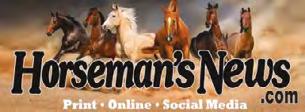


















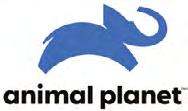





When it comes to horses, we mean business. Study the business of horses in the heartland of America’s equine industry from an AACSB accredited college of business. Our classes are led by successful and connected equine industry experts and held in state-of-the-art facilities, providing you with the skills and a network that will open your career options.
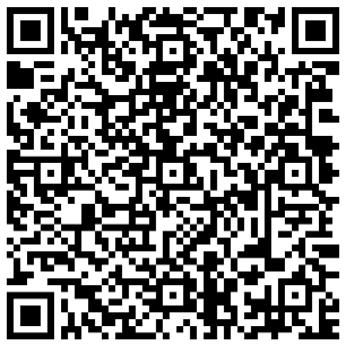
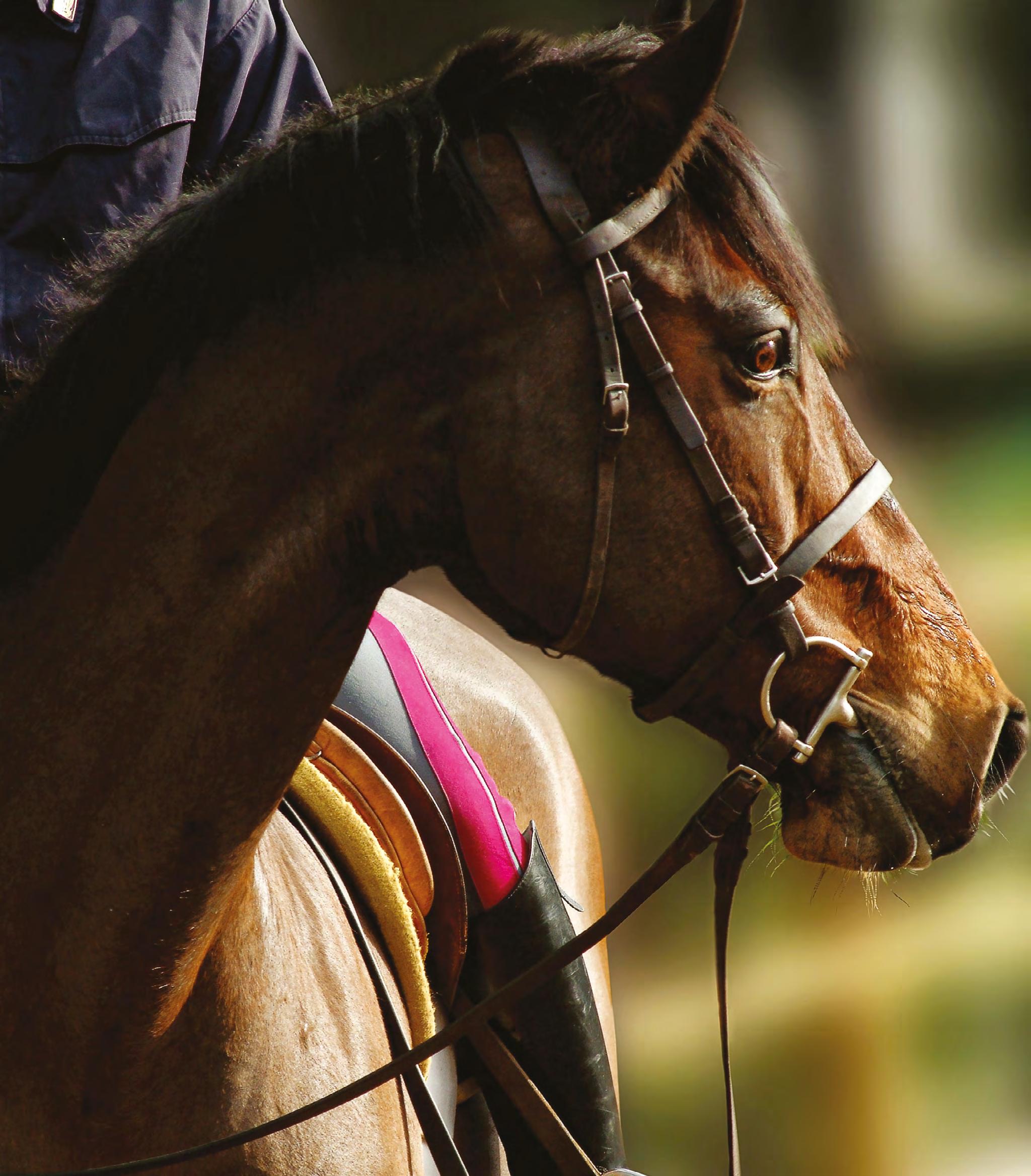
TURN YOUR LOVE OF HORSES INTO A GREAT CAREER LEARN MORE TODAY! Business.Louisville.edu/UofLEquine
 byLydiaFairchok
byLydiaFairchok















 By Lydia Fairchok
By Lydia Fairchok







 Laura King CHt, NLP, Life & Performance Coach
Laura King CHt, NLP, Life & Performance Coach






 Julie I. Fershtman, Attorney at Law www.equinelaw.net
Julie I. Fershtman, Attorney at Law www.equinelaw.net


 By Shya Beth
By Shya Beth
























 By Shya Beth
By Shya Beth
































